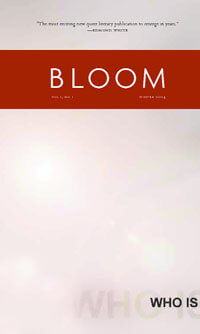Backed by luminaries on advisory board, BLOOM aims to publish stellar work
BLOOM, a journal devoted to queer prose, poetry, and art made its debut this month with a January 13 launch party at the Lesbian, Gay, Bisexual and Transgender (LGBT) Community Center. A second party and reading will be held at Creative Visions Bookstore on Thursday, January 29 and contributors Patrick Donnelly, Richard Tayson, Bea Gates, Elena Georgiou, and Steve Turtell will read.
Founded by longtime director of the Publishing Triangle, Charles Flowers, the journal’s first issue features fiction by Andrew Holleran as well as poems by Adrienne Rich and Mark Doty, and an essay by Bernard Cooper.
“About two years ago, post-9/11, I needed something to dream for, a project that excited me,” said Flowers, who has worked in publishing since 1987 and long had hopes of starting a literary journal. Luckily for him, several of his friends and co-workers at the Academy of American Poets, where Flowers works as the associate director, had launched new, successful literary magazines and gave him plenty of advice.
Flowers feels that while there are several high quality literary magazines showcasing queer fiction, BLOOM’s role is unique in the range of genres and genders presented within its pages.
“Usually the boys stick with the boys and the girls with the girls,” he said, “or there’s a limit to the genre. I really wanted to publish both lesbians and gay men, and I wanted a full range of stories, essays, poems, art, and whatever else that comes along.”
The only requirement for appearing in BLOOM is that the writer or artist be queer, not necessarily the work itself.
“The first line of our mission statement says, ‘Bloom does not discriminate against the imagination,’” Flowers explained. “I always say that if a lesbian writes an amazing piece about her parents’ divorce, we’d consider it. I like to think that there’s a queer sensibility that colors even non-queer subjects.”
Flowers said he chose the name “Bloom” to suggest beauty and hope.
“So much of the discussion around queer publishing is negative, so I wanted to suggest something positive, something on the verge of happening and becoming beautiful. And the fact that it also suggests narcissism, being so closely related to my last name, that’s icing on the cake.”
Flowers began soliciting material for the journal last spring, along with his poetry editor Joan Larkin and fiction editor Wesley Gibson, who said, “We’d like this to be like a little Paris Review.”
The editors also received referrals from the journal’s advisory board, whose members include Dorothy Allison, Carol Anshaw, Christopher Bram, E. Lynn Harris, and Edmund White. The selection process ran fairly smoothly, though Flowers anticipates that will change as awareness of the journal builds. He says that the journal is open to a range of styles and experimental material, “though it’s not my strength––I may have to ask the writer what he or she is trying to do.” His personal preference is for narrative, strong personal essays, and solid, well-crafted poems.
“Now that we have a first issue, we can actually show people what we like, what we’re looking for. Usually, when you say you’re starting a gay magazine, people wonder how many shirtless boys you’re going to put on the cover. I suspect some of the women we approached were hesitant to submit work until they knew we’re not using beefcake packaging.”
Instead of a shirtless boy, the cover of the first issue has an abstract pink and yellow photograph of light by one of the magazine’s featured artists, Amy Goldstein.
“This is a hopeful, optimistic, thing, very expansive,” said novelist Stacy D’Erasmo, whose story “And” is one of three published in BLOOM. “It gives me hope for the future during this conservative time, living through this weird, protracted war. I mean, I love ‘Queer Eye for the Straight Guy,’ but it’s not the whole picture.”
Flowers said he’s very pleased with the response to the magazine, which has gotten submissions from as far away as Ireland and Australia. He dreams of expanding the project to include a reading series, workshops for writers, and an outreach program to donate copies of each issue to community based organizations.
“And of course, we will publish books, in addition to the journal, at some point,” he said rather matter-of-factly. “But I tend to get ahead of myself.”


































